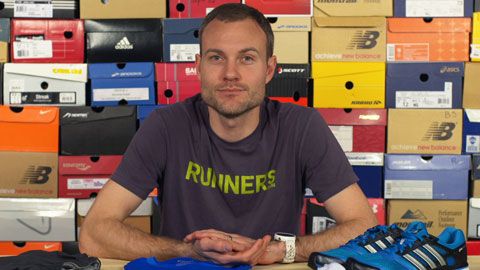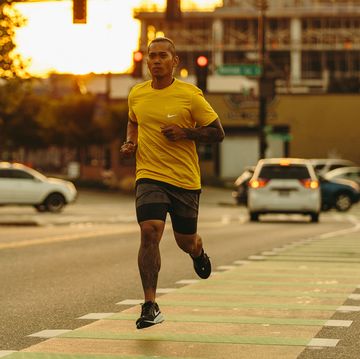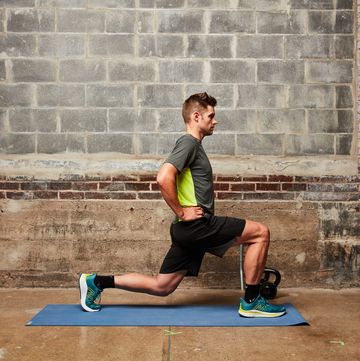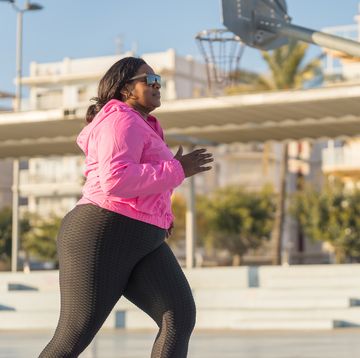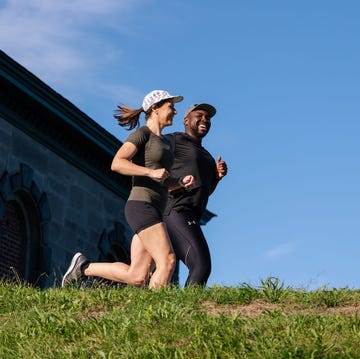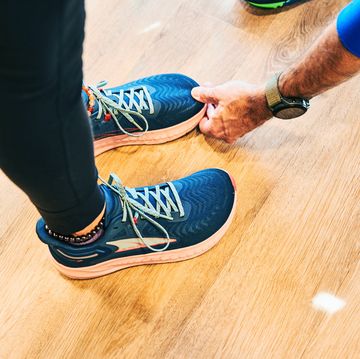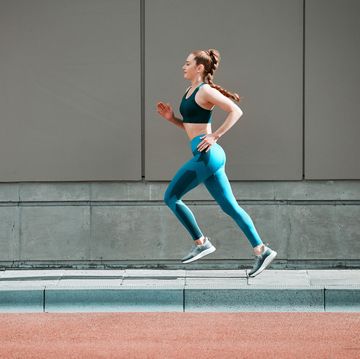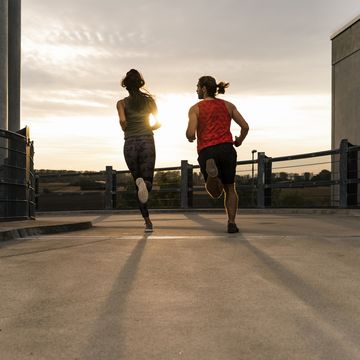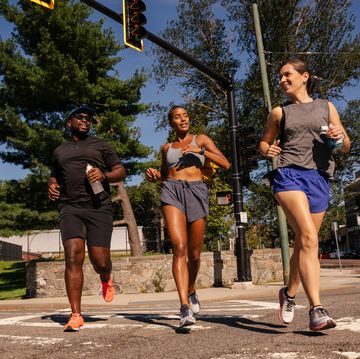Maybe you haven’t run since you were 16. Maybe you’ve literally never gone for a jog. But that doesn’t mean you can’t become a runner after 40, says Gordon Bakoulis, 56, a certified running coach and Olympics-qualifying marathoner. “Everyone’s a runner. Some people just haven’t discovered it yet—and it’s never too late.” (Just getting started? Try Runner’s World’s five step program for beginners!)
But here’s the thing: Becoming a runner in your 40s isn’t quite like picking up the sport in your 20s. When you’re older, muscles take longer to repair themselves post-workout, making pulled hamstrings, knee problems, and other aches and pains more of a risk for runners over 40, according to a Current Sports Medicine Reports study. So before you lace up your sneakers and cue up your cardio playlist, it’s important to arm yourself with the intel that will help you stay injury-free and motivated.
You have a lot to gain—but you need to be cautious.
First, the good news: Sticking to a consistent running routine may help keep age-related health concerns at bay better than walking. The added impact helps ward off osteoporosis, and since it’s more taxing on your cardiovascular system, it may offer better blood pressure control, too, says Debbie Casola, CSCS, 59, a Virginia-based personal trainer and certified running coach. But that doesn’t mean you should jump right in.
It’s best to touch base with your doctor before starting any new exercise routine after 40, especially if you haven’t been working out regularly, Casola says. You’ll want to start out knowing if your aches and pains are concerning or just the result of age-related wear and tear, and whether or not they could become aggravated by running, she says. (Make sure you’re doing these 5 foam rolling moves to ease aches and pains.) A doctor can also give you a general picture of your overall health. “Some underlying health issues can be exacerbated by sudden, intense bursts of exercise,” Bakoulis says, including migraines and heart problems.
RELATED: 4 Things You’re Doing That Are Ruining Your Joints
You don’t need a fancy GPS watch.
You’ve undoubtedly noticed that experienced runners love their gear. From GPS watches and wireless headphones to compression sleeves for their legs and arms, there can be a lot to want to get. However, new runners only really need the absolute essentials: Head to a local running specialty shop where an experienced salesperson can assess your feet (which become more susceptible to painful conditions like bunions or plantar fasciitis as you age), your running stride, and fit you with sneakers tailored to you. They’ll also make sure your shoe will appropriately align your body to lessen any ankle, knee, or hip pain, Casola says.
You’ll also want a supportive sports bra (Not sure which one to buy? One writer tried 6 different running bras and uncovered the best one.) and sweat-wicking, snug-fitting socks to prevent blisters. Other than that, wear what you already work out in. “Make sure you like this whole running thing before you go spend a ton of money on equipment you might not use,” Casola says. If you end up falling in love with the sport, you can gradually accumulate more gear.
RW's gear editor shows what gear you need to get the most out of your run.
Start small.
If you haven’t run in a decade, it doesn’t really matter that you used to run 10Ks; you need to ramp up slowly. “A mile is a long way to go right off the bat,” Bakoulis says. “It’s okay to work up to it!” In fact, experts recommend starting really small, say, with one minute or even just 30 seconds of running at a time. Here’s how you might start, according to Bennett Cohen, author of Injury Free Running for Women over 40.
If you’re already walking for 30 minutes, split that walk into 10 segments of three minutes each. Run for 30 seconds, walk for two minutes and 30 seconds, then repeat that nine more times. Try doing that three times a week. Then, he says, increase your running time to one minute the following week. “Increase in that pattern over successive weeks, and by week six, you’re running for 30 minutes nonstop!” (Find the right work-to-rest ratio here.)
Apps like the popular Couch to 5K streamline this walk-run approach by keeping time for you, alerting you when it’s time to walk and time to run, and gradually increasing the running time from week to week.
RELATED: Do You Have a Pre-Existing Condition? Look at This List to Find Out
If it feels brutal, scale back.
Maybe you expected getting back into shape to suck—and it’s proving to be even worse than you thought. That feeling is a red flag to running experts. “That’s a sign you may be trying to ramp up too quickly. It’s always better to start more conservatively,” Bakoulis says. Not only will building up slowly help you avoid injury, which is a greater threat after 40, but it will also keep you motivated. “You don’t want to dread running or have it feel onerous.”
Not sure if you’re doing too much, too soon? Assess your efforts with the talk test: You should be able to talk comfortably without gasping for breath while you run. If you can only sputter out a word at a time, you’re working too hard, Cohen says. Turn down the speed a few notches until you are moving more comfortably.
RELATED: Is It Worth Working Out Just One Day a Week?
Be kind to your body.
As we get older, it takes our bodies longer to recover; it’s just a fact of life. “A 20-year-old might never think twice about sore muscles or a minor strain, but it can end up being something that aggravates an older runner for a week,” Casola says.
With that in mind, it’s important to avoid running on consecutive days. When you’re first getting started, three runs a week should be plenty. If you want to log more than three weekly workouts, add a day of strength training to your routine, Cohen says, or hop on a bicycle or the elliptical or go for a swim on another day, Casola suggests. “This type of cross-training helps you work on your cardiovascular conditioning without pounding the pavement.” (Make sure to add these 12 essential exercises every runner should do to your weekly strength routine.)
RW IN YOUR INBOX: Have the latest news, advice, and inspiration sent to you every day with our Runner’s World Newsletters.
Warm up and post-workout recovery are also important, as they help ward off overuse injuries, and problems with knees, hamstring, and calf muscles—all things older runners are more susceptible to, according to The University of North Carolina at Chapel Hill School of Medicine findings. Stretch at the end of your runs, rather than the beginnings, since cold muscles are more prone to injury. And instead, warm up with a few minutes of walking or slow jogging.
On your days off consider foam rolling or doing yoga or Pilates to soothe sore muscles and maintain a healthy range of motion. (Never used a foam roller before? Learn about the 5 different types of foam rollers—and when to use each one.)
Running is about more than fitness.
Running can be a major stress reliever, Casola says, especially if you’re getting to spend time with friends while you’re at it. She ran her first marathon two weeks before her 40th birthday and got instantly hooked on longer distances. She started doing long training runs with other runners, making more and more running friends along the way, and eventually became a coach. For her upcoming 60th birthday, Casola, her husband, and eight running friends will be celebrating at a half-marathon. “It became a very social thing for me. Some people I run with have become lifelong friends.”
RELATED: 8 Friends Every Woman Needs
For others, running is more solitary–but equally invigorating. “I affectionately call some of the women I’ve coached ‘adult-onset runners,’ meaning they weren’t athletic in their youth,” says Cohen. “For them, it’s part of a metamorphosis. When they run, they feel like an athlete. It’s about taking control of their bodies and wellbeing.” (Here’s how running brought this couple closer together, and helped them lose 180 pounds.)
Don’t compare yourself to other runners.
It’s tough, especially with all those finish line and workout photos on Facebook, but don’t measure your running accomplishments against those of your friends, especially if they’re more seasoned runners, Casola warns. (Take note from these plus-size exercisers who have received bad advice.) Let them run their 8-minute miles while you run your 15. Be at peace while they run for an hour straight, and you take walk breaks. There are runners of all different speeds, levels, backgrounds, ages, and body types, and new runners should regularly remind themselves of that. “You are doing this for fun, for your health, not to become an Olympic athlete,” Casola says.
RELATED: 9 Ways to Be More Resilient About Anything
Keep your eye on the prize.
It’s natural for some of your initial excitement over starting a new fitness routine to wane. In those moments, “keep the end goal in mind,” Cohen says, whether it’s running in a race you signed up for, getting into shape so you can keep up with your kids, or simply feeling happier and healthier. Remember why this new habit is good for you. “Women in their 40s can be stretched in all directions,” Bakoulis says. “But running is an efficient, satisfying way to get a workout in a few times a week, spend time with friends, and have ‘me’ time.”
RELATED: 6 Tricks a Celebrity Trainer Uses on Herself to Keep the Weight Off
The article If You’re Over 40 And About To Start Running For The First Time, Here Are 8 Things You Need To Know originally appeared on Prevention.
Sarah Klein is a Boston-based writer, editor, and personal trainer currently with LIVESTRONG.com, and previously of Health.com, Prevention magazine, and The Huffington Post. She’s the graduate of the Arthur L. Carter Journalism Institute at New York University.

